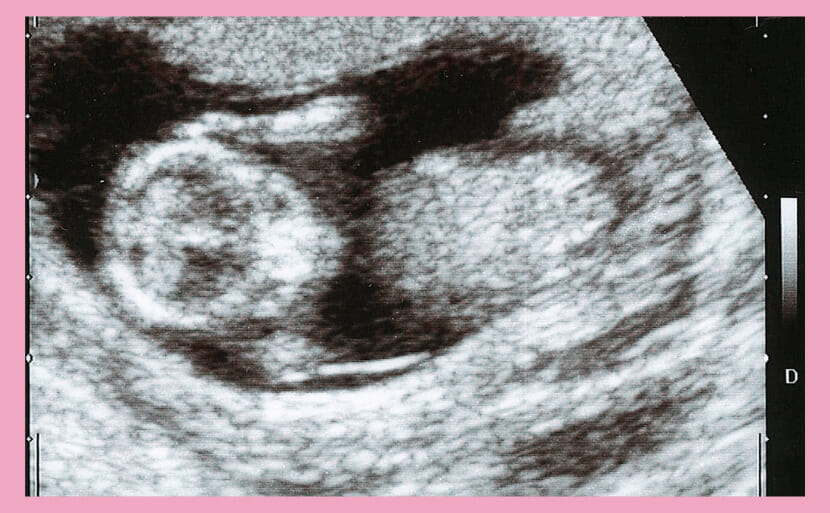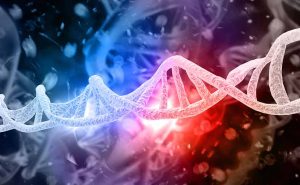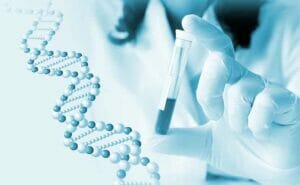The 13th week of pregnancy marks the 4th month of pregnancy. It is generally considered to be the "stable period" of pregnancy, when morning sickness subsides. In this article, our doctor explains the changes in the mother's body and the growth of the fetus that can be seen during the 13th week of pregnancy, as well as the signs of Down's Syndrome that can be detected by ultrasound.
The Baby at the 13th week of Pregnancy
Baby’s Growth at 13th week of Pregnancy
The 13th week of pregnancy is the 4th month of pregnancy. The size of the uterus becomes about the size of a grapefruit, and the length of the cephalic area (the size of the baby) grows to about 7.5 to 8 cm and the weight to about 35 to 50 g. The baby’s appearance also becomes closer to what it will look like when it is born. This is an important period as various organs such as lungs, stomach, and kidneys are formed.
At the 13th week of the pregnancy, the fetus will have developed the bones of the head and limbs. Swallowing movements and fetal bowel movements may also begin. In the uterus, the fetus shows complex movements such as opening and holding its hands repeatedly and bending and stretching its legs.
Blood, which was previously produced in the yolk sac, an organ that is exclusive to the fetus, is shifted to hematopoiesis in the liver and spleen due to the development of the organs. The fetus repeatedly drinks and expels amniotic fluid and begins to practice breathing at the 13th week of pregnancy. Kidneys are also formed, and urinary behavior can be observed in the amniotic fluid by ultrasound.
Gender Identification of the Baby at 13 Weeks of Pregnancy
The gender of the fetus is already fixed at conception (at the time of fertilization). At 13 weeks of pregnancy, the genitalia begin to form as either male or female. Gender determination by ultrasound is possible after 18 to 20 weeks of pregnancy. However, since it is done visually, it may not be accurate.

This is an ultrasound image at the 13th week of pregnancy.
What is gender identification by NIPT (New Non-invasive Prenatal Testing)?
NIPT (New Non-invasive Prenatal Testing) is a screening test that examines fetal DNA using only maternal blood to detect the risk of chromosomal abnormalities such as Down syndrome, etc.
NIPT (New Non-invasive Prenatal Testing) is not a definitive test. However, it is a highly accurate test for Down syndrome, with a sensitivity and specificity of 99.9%. Another feature of NIPT is that it is non-invasive, meaning that the test can be performed without causing any damage to the fetus.
NIPT (New Non-invasive Prenatal Testing) can be performed from the 10th week of pregnancy. In addition to the risk of chromosomal abnormalities, the sex chromosomes, which determine the sex of the baby, can be examined, so it is possible to know early in the pregnancy whether the fetus will be a boy or a girl.
Test Items to be determined in NIPT (New Non-invasive Prenatal Testing) by Hiro Clinic NIPT
- Gender Identification
- Down Syndrome
- Edwards Syndrome
- Patau Syndrome
- Sex Chromosome Abnormality
- Triple-X Syndrome
- Klinefelter’s syndrome
- 47,XYY syndrome, etc.
Changes in the Mother’s Body
at 13 Weeks of Pregnancy
The State of the Maternal Body at 13 Weeks of Pregnancy
The 13th week of pregnancy is the time when the placenta is nearing completion and the baby is entering what is generally referred to as the stable period. Although it varies from person to person, the peak of morning sickness (around 7 to 11 weeks of pregnancy) has passed, and many pregnant women may find that morning sickness symptoms have subsided.
The fetus at 13 weeks of pregnancy is said to be about the size of a grapefruit, and the bulging of the belly is not likely that visible. If you wear loose-fitting clothes and have a voluptuous figure, people around you may not even notice that you are pregnant. Many pregnant women often also complain of breast pain and back pain.
Although morning sickness subsides, it is important to refrain from strenuous exercise and heavy lifting during the 13th week of pregnancy, as the heart rate and cardiac output (the amount of blood pumped from the heart to the rest of the body) increase.

What to Watch Out for and Problems Likely to Occur During the 13th Week of Pregnancy
Iron-deficiency Anemia
Anemia during pregnancy is a common condition that occurs in many pregnant women. The main causes of anemia during pregnancy are iron deficiency and folate deficiency.
Blood is responsible for carrying oxygen throughout the body. Thus, if anemia is left ignored, it is common for patients to experience dizziness and shortness of breath. During pregnancy, about twice as much iron is needed as before pregnancy to produce blood (red blood cells) for the fetus, and anemia in pregnant women due to iron deficiency can cause acid deficiency in the fetus. It is said that 90% of pregnant women are iron deficient, and it is advisable to keep iron consumption in mind in the diet during pregnancy.
It is also important to note that anemia due to folic acid deficiency can cause birth defects and neural tube defects in the fetal brain.
Currently, many supplements and other products for pregnant women are available on the market. However, before taking supplements , consult your physician about your anemic symptoms.
Constipation
During pregnancy, a hormone called progesterone is actively secreted. This hormone has the effect of suppressing bowel movement, causing constipation in pregnant women.
Constipation during pregnancy can also be caused by morning sickness, which can lead to decreased food and fluid intake, and lack of exercise. In many cases, constipation is also caused by the burden placed on the digestive system by taking iron pills. It is advisable to consume plenty of water and dietary fiber, and to engage in light exercise such as walking.
Back Pain
Pregnancy increases the secretion of a hormone called relaxin. This hormone relaxes the joints at the pelvic joints (sacroiliac ligaments and pubic symphysis) in order to facilitate the passage of the baby through the birth canal during delivery. As a result, the muscles of the hips and back are stressed during pregnancy, which can cause symptoms of pelvic pain as well as lower back pain.
Relaxin also has the effect of pooling blood in the pelvic region, which can make the lower back feel heavier. These effects increase the load on the lower back during pregnancy, making it more susceptible to back pain.
Warming the lower back and wearing a pelvic supporter are some of the ways to deal with back pain during pregnancy, but should be used only after consulting with your doctor.
Headache
There are many causes of headaches during pregnancy. In addition to stress during pregnancy, lack of exercise, and insomnia due to morning sickness, Progesterone ( Progestin) is also a common cause in early to mid pregnancy.
Pregnant women should practice caution when taking over-the-counter medications. Some painkillers are not recommended, so be sure to consult with your doctor and use them according to the prescribed dosage and usage.
Risk of Miscarriage
It is reported that 90% of all miscarriages tend to occur at an early age, less than 12 weeks of pregnancy, and the cause of early miscarriage is reportedly congenital abnormality on the part of the fetus.
The 13th week of pregnancy is the time when morning sickness subsides and the placenta is nearing full completion. The probability of miscarriage decreases, but the possibility of an abrupt miscarriage is not zero. If you experience bleeding, abdominal pain, or any other physical irregularities, consult your doctor as soon as possible.
Testing at 13th Week of Pregnancy
Maternity Checkup
The following tests are performed during a maternity checkup at around the 13th week of pregnancy:
| Blood Pressure Monitoring | To monitor for any abnormalities, such as gestational hypertension. |
|---|---|
| Weight Measurement | To check for changes in body weight and to check for abnormalities such as gestational hypertension and gestational diabetes mellitus. |
| Blood Test | To check for anemia, gestational diabetes, and other abnormalities. |
| Urinalysis | To detect early stage of diseases such as gestational hypertension and gestational diabetes mellitus. |
| Abdominal Circumference Measurement | It serves as a guide to determine if there are any problems with the uterus, the size of the baby, or the amount of amniotic fluid. |
| Fundal Height Measurement | It is a standard to determine if there are any problems with the uterus, the size of the It provides a guide to determine if there are any problems with the uterus, the size of the baby, or the amount of amniotic fluid. |
| Transabdominal Ultrasound | Ultrasound Fetal Measurement It examines the estimated weight of the fetus, major malformations, the umbilical cord, placenta, heartbeat, body movements, and the amount of amniotic fluid. |
| Fetal Doppler (Baby’s Heartbeat) | It checks the baby’s heart rate and heart rhythm to check for heart disease and the baby’s health. |
Signs of Down Syndrome at the 13th week of Pregnancy on Ultrasound
Down syndrome, or Trisomy 21, is a chromosomal abnormality that occurs when the 21st chromosome is increased by one more than the normal number. It causes mental disabilities and physical developmental delays, and is considered the most common congenital disorder.
Down Syndrome can be recognized on Ultrasound
only after the 11th week of pregnancy
After the 11th week of pregnancy, the physical characteristics of the fetus can be observed with an ultrasound. The following characteristics will appear if there is a possibility of Down syndrome:
- Swelling of the back of the neck
- Nose shape ( slow growth of nasal bones)
- Head size
- Heart abnormalities
The diagnostic evaluation of Down syndrome by ultrasound is done visually, so it is not a definitive assessment. It is difficult to identify the signs of Down syndrome in early pregnancy, especially when there is a cardiac condition.
On the other hand, NIPT (New Non-invasive Prenatal Testing) enables screening for Down syndrome and other chromosomal abnormalities from as early as 10 weeks of pregnancy.

Prenatal Testing for Risk of Down Syndrome
from 10 Weeks of Pregnancy
NIPT(Non-invasive Prenatal Testing)
NIPT (Non-invasive Prenatal Testing) is a screening test in which about 10 ml of blood is drawn from the mother to determine the risk of chromosomal abnormalities based on fetal DNA contained in the mother’s blood. There is no direct invasion (damage) to the fetus, and the risk of miscarriage is extremely low. Another feature of NIPT is that the test can be performed as early as 10 weeks of pregnancy and is a highly accurate prenatal test with a sensitivity and specificity of 99.9% for Down syndrome.
Get tested at Hiro Clinic NIPT at your 10th week of Pregnancy
Down syndrome is a congenital disorder caused by chromosomal abnormalities. It is also considered the most common chromosomal abnormality.
Down syndrome can result in intellectual disability, delayed physical development, and many complications, including heart disease. Knowing whether or not the baby is at risk for Down syndrome prior to birth can help prepare the baby for medical and living conditions after birth.
If you have any inquiries about NIPT (Non-invasive Prenatal Testing), the gender of your baby, or Down Syndrome, Hiro Clinic NIPT is here to help you. Our doctors and staff will do their best to help you have a healthy pregnancy and delivery.
【References】
- Ministry of Health, Labour and Welfare – 健やかな妊娠と出産のために
The 13th week of pregnancy marks the 4th month of pregnancy. It is generally considered to be the "stable period" of pregnancy, when morning sickness subsides. In this article, our doctor explains the changes in the mother's body and the growth of the fetus that can be seen during the 13th week of pregnancy, as well as the signs of Down's Syndrome that can be detected by ultrasound.
Article Editorial Supervisor

Dr Hiroshi Oka
NIPT specialist clinic, MD
Graduated from Keio University, School of Medicine
 中文
中文























